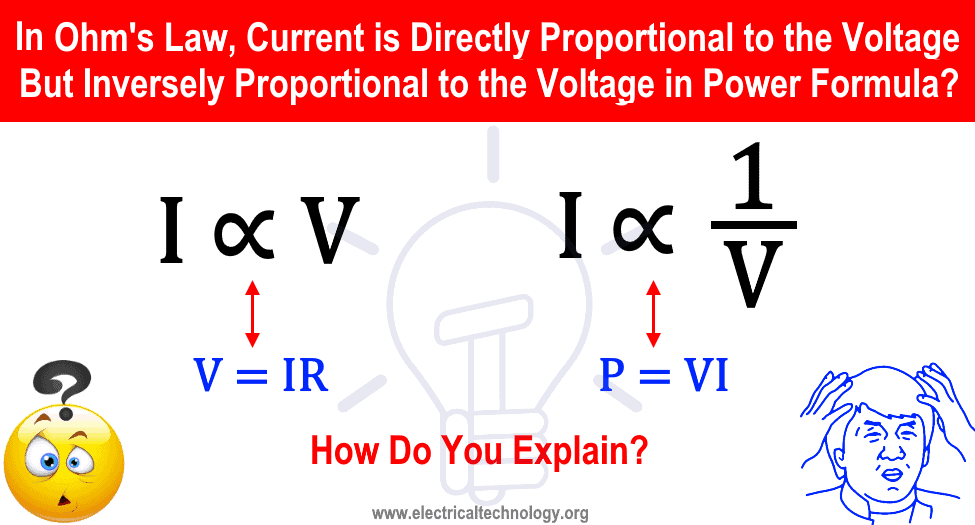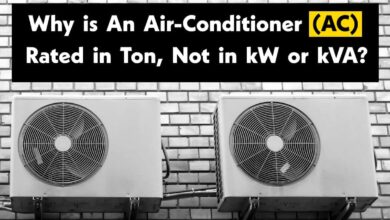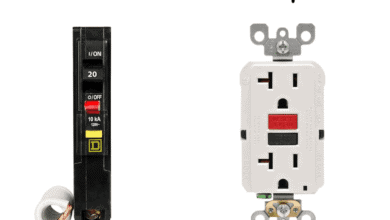According to Ohm’s Law, I ∝ V, But I ∝ 1/V in Power Equation. Explain?
In I = V ÷ R, Current is Directly Proportional to the Voltage, But Current is Inversely Proportional to the Voltage in P = V × I?
This is another confusing question mostly asked in electrical and electronics engineering interviews as is follow.
According to Ohm’s Law, Current Increases when Voltage increases (I=V ÷ R), but Current decreases when Voltage increases according to (P = V × I) formula. How do you explain?
i.e.
- According to Ohm’s Law: I ∝ V (Current directly proportional to the Voltage. I = V ÷ R)
- According to Power Formula: I ∝ 1 ÷ V (Current is inversely proportional to the Voltage. I = P ÷ V)
In short, according to the Ohm’s Law (V = I × R or I = V ÷ R) which shows that Current is directly proportional to the Voltage, but according to P = V × I or I = P ÷ V, it shows that Current is inversely proportional to the Voltage.
Let’s clear the confusion about the statement.
P = V × I
Actually, it depends on how you increase the parameters i.e. if you increase the voltage by keeping the power of the source constant or is it varying.
- If the power of the source is constant then the current would decrease when voltage increases.
- If you don’t care about the power and just simply replace the battery with a new one’s with higher power rating this can increase the current when voltage increase as power is no more constant i.e. power has been also increased.
In case of transformer, when voltage increases then current decrease because power remains constant i.e. both side power is P = VI (neglecting the power factor: Cos θ).
V = I × R
By Ohm’s Law, Current (I) is directly proportional to the Voltage (V) if Resistance (R) and Temperature remain constant.
- V = I × R
- R = V ÷ I
- I = V ÷ R
According the power formula, It says that Current is inversely proportional to the voltage if power remain same.
- P = V × I
- I = P ÷ V
- V = P ÷ I
As we already know that in a step-up transformer, if voltage increases, the current decreases where power is same (as transformer only step-up or step-down the value of current and voltage and doesn’t change the value of power). Similarly, voltage decreases when current increases in a step-down transformer.
The same story is there at the generating station where power generation is constant. If power at generation side improves, both current and voltage will be increased.
In short:
- If power is constant = Voltage is Inversely proportional to the Current i.e. V ∝ 1 ÷ I in P = V × I.
- If resistance and Temperature are constant: Voltage is directly proportional to the Current i.e. V ∝ I in V = I × R.
That’s is the exact reason why in Ohm’s Law, Current is Directly Proportional to the Voltage But Inversely Proportional to the Voltage in Power formula.
Related Questions/Answers:
- Is it Possible to Operate a 50Hz Transformer on 5Hz or 500Hz Frequency?
- Which Transformer is More Efficient When Operates on 50Hz or 60Hz?
- Can We Operate a 60Hz Transformer on 50Hz Supply Source and Vice Versa?
- Is Lightning AC or DC ?
- Why Transformer Does not Work on DC Supply instead of AC?
- In a Capacitive Circuit, Why the Current Increases When Frequency Increases?
- In an Inductive Circuit, Why the Current Increases When Frequency Decreases?
- Why Power Factor Decreases When Inductance or Inductive Reactance Increases?
- Why Power Factor Decreases When Capacitive Reactance Increases or Capacitance Decreases?








THANK YOU! I HAD FIGURED THAT OUT A FEW YEARS AGO BUT IN STUDYING ALL THE HIGHER LEVEL STUFF FORGOT THE BASICS!
Thanks for easy expalantion!
yes I concluded that if power is constant then p=vi holds good , when power varies then ohm’s law as to be used is it correct.
can u please explain how to keep power constant in generation side .
suppose if power varies in generation side then what happens,will current increases with increase in voltage.Please explain I’m waiting for your reply.
This is for explanation purpose only… in ideal case, where the input power at generation side is equal to the the receiving end power (consider zero% losses).. the best example is Electrical Transformer where power is remain constant while current or voltage may step up or step down which depends on the transformer primary and Secondary winding design and positions.
High Voltage = Low Amp
Low Voltage = High Amp
Is that correct?
In case of P = VI, When P is constant, then correct.
I do not completely agree, for instance a 10hp motor running on 60% load is fed 415V, it will draw around 9A. If the same motor is fed 380V, it will draw 7-7.5A. So when motor is not running on full load capacity it will draw less current.
You assume the power of 10 hp in both cases. i.e. power is constant. So yes, Current decreases when voltage decreases and vice versa i.e. Current is directly proportional to the voltage in this case.
The current behave differently in coil of the heater and in a normal conductor. My point is what is the difference between the two conductor. The 12V system in the car glows a bulb and the same voltage produces heavy torque also through starter. PLEASE EXPLAIN! THANKS!
How to calculate power when we are applying ohms law?
Not Ohm’s Law, but P =VI in DC Circuits,
P = VI Cos θ … (in single phase Ac Circuit)
P = 1.732 x V x I x Cos θ (in three phase circuit)
where Cos θ = Power factor and 1.732 = Under the root 3
Awesome explanation. I had same question and was searching for its solution. Now I got it. Thanks.
Nice and simple explanation. I was having the same question and searching for solution. But after reading this every thing is clear to me. Please keep doing good deeds like this. Thanks a lot.
THANKS to the one who explained this article . was in little confusion . but now its clear . Thanks!!
Ohm’s law is applicable at constant temperature.. current and voltage are directly proportional at constant temperature… but for variable temperature p= vi .. current and voltage are inverse… is that correct admin.. waiting for reply..
Dear Sir can u please Explain which Type of Thyristors and Capacitors are used in Induction melting furnace?
And Tell me why that type of used?
This has been the most help I have found on the web, Thank you This cleared everything up.
HELLO GUYS.
I HAVE A INTERVIEW IN P&G. AFTER FEW DAYS CAN U PLZ SUGGEST ME A INTERVIEW QUESTION ASK IN TECHNICAL ROUND FOR ELECTRICAL ENGINEER.
I agree that if power is constant and then if voltage is increased then the current is decreased but if consider the resistance of wire carrying current then by ohm’s law current should be increased.
So how will explain this ?
In this case, temperature is not constant, that’s why current decreases.
Thanks for explanation. I was also confused due to transformer.
If the current in a circuit decreases the power dissipated by that circuit will ….. i need help
If current decreases the power dissipated in circuit is decreases ,because power loss is I Squire R ,that’s why we are using high voltage transmission line for power transmission line .P=VI
If power is constant then p=vi holds good , when power varies then ohm’s law as to be used is it correct ??
this is true?
Please give an example when and where ohm’s law is applicable?
I very much Interested in your page
in the text there you have : V = P/V
but it should be V = P/ I.
Thanks for correction. Updated now.
Thanks!!! U have explained it in a very simple way.
Keep up the good work ?
If power ,resistance,temperature are constant .Then it obeys which law?.